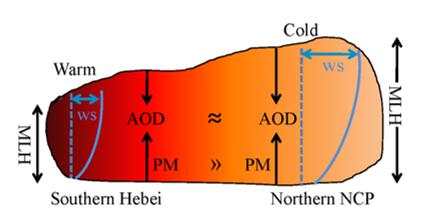Shijiazhuang, Xingtai and Handan in the southern North China Plain (NCP) have been the most serious polluted areas in China. Except for the large amount of emission, boundary layer meteorology, i.e. meteorological factors in the boundary layer, such as temperature, humidity, planetary boundary layer (PBL), wind speed and direction, etc., is an important factor that cannot be ignored. At present, the continuous observation of conventional meteorological factors has been operational, but the long time high-resolution observation of the boundary layer structure is extremely scarce.
Since 2009, Dr. TANG Guiqian in the research group led by WANG Yuesi from the Institute of Atmospheric Physics (IAP) has monitored the evolution of regional atmospheric mixing layer height (MLH) in the NCP. Through 9-year observations, they found that the ceilometers can provide accurate observations of MLH in heavy haze pollution, and the optimal observation station distance in NCP was 60 km. The research also demonstrated that prevailed sea-breeze circulation in summer caused the formation of thermal internal boundary layer in coastal cities (e.g., Qinhuangdao), which induced a multiple structures in boundary layer. Annual means of MLH in Shijiazhuang (464 m) were 15.0% and 21.9% lower than Beijing (594 m) and Tianjin (546 m).
Analysis of turbulent kinetic energy revealed that low MLH in southern Hebei was related with weak wind shear. As a result, the unfavorable weather conditions in southern Hebei should be considered in the future adjustment of industry and energy structure.

The schematic diagram of the meteorological causes for heavy haze in southern Hebei (Image by TANG Guiqian)
"Elimination of the backward production capacity, use of clean energy, and optimization of industrial structure are the best way to improve the air quality in this area.” Says TANG.
This research was supported by the National Key R&D Program of China, National Natural Science Foundation of China, and the CAS Strategic Priority Research Program Grants.
Reference
[1].Tang, G., Zhang, J., Zhu, X., Song, T., Münkel, C., Hu, B., Schafer, K., Liu, Z., Zhang, J., Wang, L., Xin, J., Suppan, P., and Wang, Y.: Mixing layer height and its implications for air pollution over Beijing, China, Atmos. Chem. Phys., 16, 2459-2475, doi:10.5194/acp-16-2459-2016, 2016.
https://www.atmos-chem-phys.net/16/2459/2016/
[2]. Zhu, X., Tang, G., Guo, J., Hu, B., Song, T., Wang, L., Xin, J., Gao, W., Münkel, C., Schafer, K., Li, X., and Wang, Y.: Mixing layer height on the North China Plain and meteorological evidence of serious air pollution in southern Hebei, Atmos. Chem. Phys., 18, 4897-4910, doi: 10.5194/acp-18-4897-2018, 2018.
https://www.atmos-chem-phys.net/18/4897/2018/
[3]. Zhu, X., Tang, G., Lv, F., Hu, B., Cheng, M., Münkel, C., Schafer, K., Xin, J., An, X., Wang, G., Li, X., Wang, Y., The spatial representativeness of mixing layer height observations in the North China Plain, Atmos. Res., 209, 204-211, doi: 10.1016/j.atmosres.2018.03.019, 2018.
https://www.sciencedirect.com/science/article/pii/S0169809517310876
[4].Wei, J., Tang, G., Zhu, X., Wang, L., Liu, Z., Cheng, M., Münkel, C., Li, X., and Wang, Y., Thermal internal boundary layer and its effect on air pollutants during summer in a coastal city in North China, J. Environ. Sci., doi: 10.1016/j.jes.2017.11.006, 2017.
